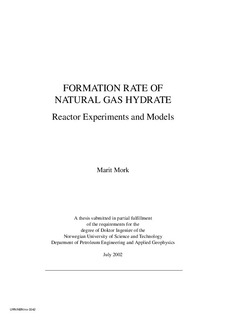| dc.contributor.author | Mork, Marit | nb_NO |
| dc.date.accessioned | 2014-12-19T11:25:05Z | |
| dc.date.available | 2014-12-19T11:25:05Z | |
| dc.date.created | 2002-11-12 | nb_NO |
| dc.date.issued | 2002 | nb_NO |
| dc.identifier | 125990 | nb_NO |
| dc.identifier.isbn | 82-471-5507-9 | nb_NO |
| dc.identifier.uri | http://hdl.handle.net/11250/231310 | |
| dc.description.abstract | The rate of methane hydrate and natural gas hydrate formation was measured in a 9.5 litre stirred tank reactor of standard design. The experiments were performed to better understand the performance and scale-up of a reactor for continuous production of natural gas hydrates. The hydrate formation rate was measured at steady-state conditions at pressures between 70 and 90 bar and temperatures between 7 and 15 °C. Between 44 and 56 % of the gas continuously supplied to the reactor was converted to hydrate.
The experimental results show that the rate of hydrate formation is strongly influenced by gas injection rate and pressure. The effect of stirring rate is less significant, and subcooling has no observable effect on the formation rate. Hydrate crystal concentration and gas composition do not influence the hydrate formation rate. Observations of produced hydrate crystals indicate that the crystals are elongated, about 5 μm in diameter and 10 μm long. Analysis of the results shows that the rate of hydrate formation is dominated by gas-liquid mass transfer. A mass transfer model, the bubble-to-crystal model, was developed for the hydrate formation rate in a continuous stirred tank reactor, given in terms of concentration driving force and an overall mass transfer coefficient. The driving force is the difference between the gas concentration at the gas-liquid interface and at the hydrate crystal surface. These concentrations correspond to the solubility of gas in water at experimental temperature and pressure and the solubility of gas at hydrate equilibrium temperature and experimental pressure, respectively. The overall mass transfer coefficient is expressed in terms of superficial gas velocity and impeller power consumption, parameters commonly used in studies of stirred tank reactors.
Experiments and modeling show that the stirred tank reactor has a considerable potential for increased production capacity. However, at higher hydrate production rates the capacity will be limited by heat transfer in the reactor. For a higher production capacity and in scale-up of the hydrate production process, the upstream gas supply system and the downstream separator must be increased in proportion to the reactor capacity. | nb_NO |
| dc.language | eng | nb_NO |
| dc.publisher | Fakultet for ingeniørvitenskap og teknologi | nb_NO |
| dc.relation.ispartofseries | Dr. ingeniøravhandling, 0809-103X; 2002:115 | nb_NO |
| dc.title | Formation Rate of Natural Gas Hydrate - Reactor Experiments and Models | nb_NO |
| dc.type | Doctoral thesis | nb_NO |
| dc.source.pagenumber | 186 | nb_NO |
| dc.contributor.department | Norges teknisk-naturvitenskapelige universitet, Fakultet for ingeniørvitenskap og teknologi | nb_NO |
| dc.description.degree | dr.ing. | nb_NO |
| dc.description.degree | dr.ing. | en_GB |
